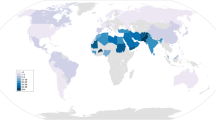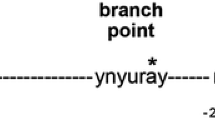Abstract
Polymorphism of theHLA-G gene in a Japanese population was investigated employing polymerase chain reaction (PCR)-single-strand conformation polymorphism (SSCP) analysis, PCR sequence-specific oligonucleotide (SSO) analysis, and DNA direct sequencing. Nucleotide sequence variations in exons 2, 3, and 4 of theHLA-G gene in 54 healthy Japanese individuals were examined. In addition, seven Japanese samples carrying commonHLA haplotypes were analyzed. In total, nine single-base substitutions compared with the sequence ofG * 1011 were identified: one in intron 1 (nucleotide position 970), one in exon 2 (the third base of codon 57: G→A), three in intron 2 (1264, 1276, and 1292), three in exon 3 (the third base of codon 93: C→T, the third base of codon 107: A→T, and the first base of codon 110: C→A), and one in intron 3 (2334). The substitution at codon 110 was non-synonymous and led to an amino acid substitution from leucine to isoleucine. The other three nucleotide substitutions in exons were synonymous. Through analysis of combinations of the exon 2, 3, and 4 nucleotide sequences we identified four alleles, which we provisionally designatedGJ1, GJ2, GJ3, andGJ4. The allele frequencies were estimated to be 0.33, 0.16, 0.45, and 0.06, respectively. Nucleotide sequences ofGJ1, GJ2, andGJ4 were identical toG * 01011, the clone7.0E, andG * 01013, respectively.GJ3 was a newly observed allele and was officially designatedG * 0104 by the WHO Nomenclature Committee in January 1996. Strong positive associations were observed betweenHLA-G alleles andHLA-A,-B, or-DRB1 alleles.
Similar content being viewed by others
References
Alizadeh, M., Legras, C., Semana, G., Le Bouteiller, P., Genetet, B., and Fauchet, R. Evidence for a polymorphism of HLA-G gene.Hum Immunol 38: 206–212, 1993
Bannai, M., Tokunaga, K., Lin, L., Kuwata, S., Mazda, T., Amaki, I., Fujisawa, K., and Juji, T. Discrimination of human HLA-DRB1 alleles by PCR-SSCP (single-strand conformation polymorphism) method.Eur J Immunogenet 21: 1–9, 1994
Bodmer, J. G., Marsh, S. G. E., Albert, E. D., Bontrop, R. E., Charron, D., Bodmer, W. F., Dupont, B., Erlich, H. A., Mach, B., Mayr, W. R., Parham, P., Sasazuki, T., Schreuder, G. M. Th., Strominger, J., Svejgaard, A., and Terasaki, P. I. Nomenclature for factors of the HLA system, 1995.Tissue Antigens 46: 1–18, 1995
Chumbley, G., King, A., Holmes, N., and Loke, Y. W. In situ hybridization and northern blot demonstration of HLA-G mRNA in human trophoblast populations by locus-specific oligonucleotide.Hum Immunol 37: 17–22, 1993
Ellis, S. A., Palmer, M. S., and McMichael, A. J. Human trophoblast and the choriocarcinoma cell line BeWo express a truncated HLA class I molecule.J Immunol 144: 731–735, 1990
Geraghty, D. E., Koller, B. H., and Orr, H. T. A human major histocompatibility complex class I gene that encodes a protein with a shortened cytoplasmic segment.Proc Natl Acad Sci USA 84: 9145–9149, 1987
Houlihan, J. M., Biro, P. A., Harper, H. M., Jenkinson, H. J., and Holmes, C. H. The human amnion is a site of MHC class Ib expression: evidence for the expression of HLA-E and HLA-GJ Immunol 154: 5665–5674, 1995
Kovats, S., Main, E. K., Librach, C., Stubblebine, M., Fisher, S. J., and DeMars, R. A class I antigen, HLA-G, expressed in human trophoblasts.Science 248: 220–223, 1990
Lata, J. A., Tuan, R. S., Shepley, K. J., Mulligan, M. M., Jackson, L. G., and Smith, J. B. Localization of major histocompatibility complex class I and II mRNA in human first-trimester chorionic villi by in situ hybridization.J Exp Med 175: 1027–1032, 1992
McMaster, M. T., Librach, C. L., Zhou, Y., Lim, K. H., Janatpour, M. J., DeMars, R., Kovats, S., Damsky, C., and Fisher, S. J. Human placental HLA-G expression is restricted to differentiated cytotrophoblasts.J Immunol 154: 3771–3778, 1995
Morales, P., Corell, A., Martinez-Laso, J., Martin-Villa, J. M., Varela, P., Paz-Artal, E., Allende, L. M., and Arnaiz-Villena, A. Three newHLA-G alleles and their linkage disequilibria withHLA-A.Immunogenetics 38: 323–331, 1993
Orita, M., Iwahama, H., Kanazawa, H., Hayashi, K., and Sekiya, T. Detection of polymorphisms of human DNA by gel electrophoresis as single-strand conformation polymorphisms.Proc Natl Acad Sci USA 86: 2766–2770, 1989
Sambrook, J., Fritsch, E. F., and Maniatis, T.Molecular Cloning: A Laboratory Manual, Cold Spring Harbor Laboratory, Cold Spring Harbor, 1989
Tamaki, J. Analysis of polymorphism at the human class I MHC locus, HLA-G [in Japanese].J Med Sci Hokkaido 67: 583–594, 1992
Tamaki, J., Arimura, Y., Koda, T., Fujimoto, S., Fujino, T., Wakisaka, A., and Kakinuma, M. Heterogeneity of HLA-G genes identified by polymerase chain reaction/single strand conformational polymorphism (PCR/SSCP).Microbiol Immunol 37: 633–640, 1993
Tokunaga, K., Omoto, K., Akaza, T., Akiyama, N., Amemiya, H., Naito, S., Sasazuki, T., Satoh, H., and Juji, T. Haplotype study onC4 polymorphism in Japanese: Associations with MHC alleles, complotypes, andHLA-complement haplotypes.Immunogenetics 22: 359–365, 1985
Van der Ven, K., and Ober, C. HLA-G polymorphisms in African Americans.J Immunol 153: 5628–5633, 1994
Yelavarthi, K. K., Fishback, J. L., and Hunt, J. S. Analysis of HLA-G mRNA in human placental and extraplacental membrane cells by in situ hybridization.J Immunol 146: 2847–2854, 1991
Author information
Authors and Affiliations
Additional information
The names listed for these sequences have been officially assigned by the WHO Nomenclature Committee. This follows the agreed policy that, subject to the conditions stated in the most recent Nomenclature Report (Bodmer et al. 1995), names will be assigned to new sequences as they are identified. Lists of such new names will be published in the following WHO Nomenclature Report. The nucleotide sequence data reported in this paper have been submitted to the DDBJ nucleotide sequence database and have been assigned the accession numbers D67003-D67011 and D77998-D78000
Rights and permissions
About this article
Cite this article
Yamashita, T., Fujii, T., Watanabe, Y. et al. HLA-G gene polymorphism in a Japanese population. Immunogenetics 44, 186–191 (1996). https://doi.org/10.1007/BF02602584
Received:
Revised:
Issue Date:
DOI: https://doi.org/10.1007/BF02602584




